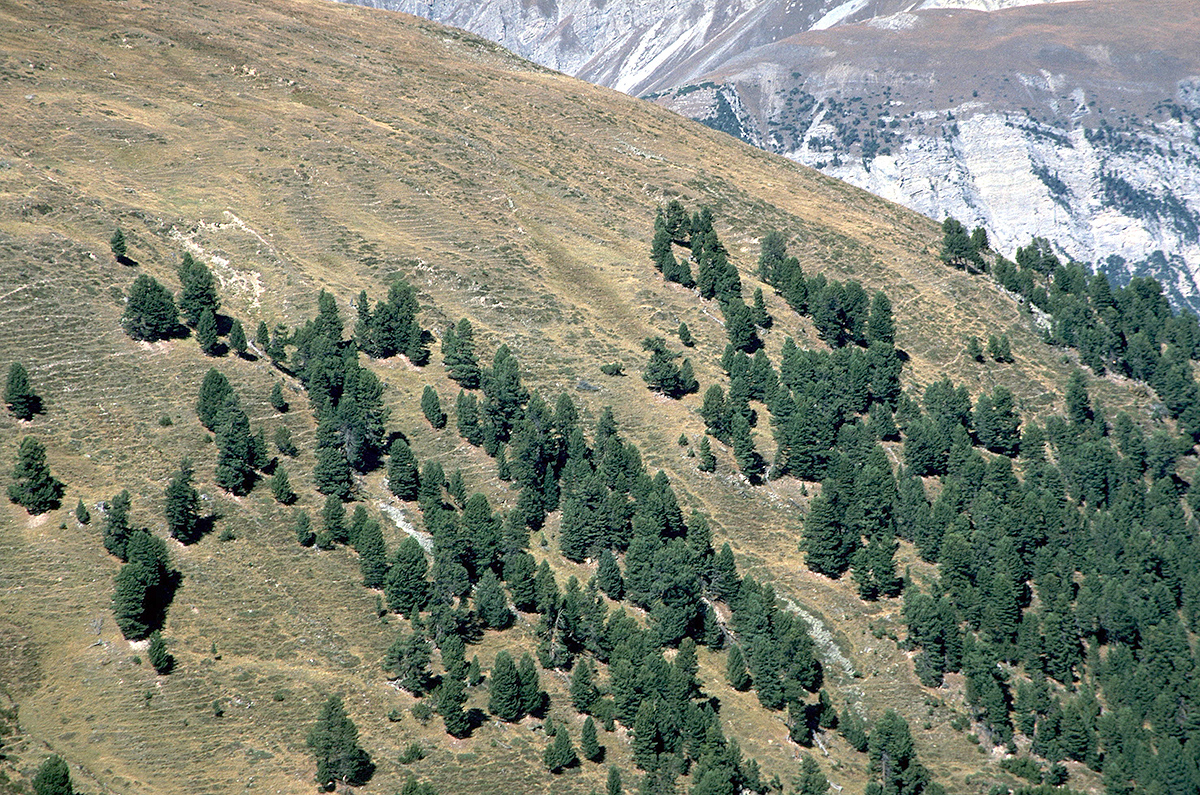In the Alps climate change related effects on tree line ecosystems are hardly detectable due to the superimposing effect of decreasing land-use. However, in the remote Ural Mountains comparisons with historical photographs indicate that the timberline has increased by 40 to 80 m in altitude during the last century very likely due to climatic changes.
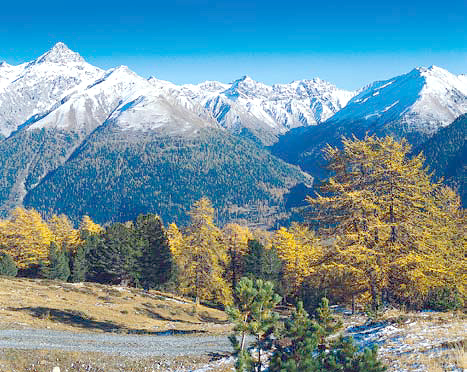
Fig. 1 - The timberline is the line, which limits a closed forest. In central alpine valleys, like here in Engadin it reaches much higher altitudes than in the Pre-Alps. Photo: Photo Furter, Davos
The Earth is becoming warmer. In the last 100 years the average temperature worldwide has increased by approximately 0.6°C. Mountains are being affected by this on-going climate change. Glaciers are melting, permafrost is thawing and snow cover is less in central areas. How are these increases in temperature affecting our animate environment?
Weather during the period of vegetation is decisive
A specific feature of the landscape in alpine mountains is the tree or timberline. The timberline is the line, which limits a closed forest, whereas the tree line includes the highest upward-growing tree. Why do trees disappear above a certain altitude? At a first glance one could think that lower winter temperatures or extreme frosts damage trees more than smaller plants. This however is not the case, as trees are able to adapt themselves to temperatures of as low as –60°C by storing sugar and other protective elements in their tissues cells.
Temperature readings at the timberline all around the globe show that it is mainly too cool conditions during the vegetation period, which determine the altitude of the tree line. In the rooting zone the temperature must be at least 5 to 7°C in order for the metabolic processes needed for tree growth to be able to take place. If the vegetation period is too short or too cold trees cannot invest enough energy in the production of a straight stem. At the tree line trees even hinder themselves: Due to shading they cool down their own root area, which makes them less competitive than smaller plants.
The altitude of the timberline is not only strongly influenced by summer temperatures, but local phenomena also play a role: movement of snow; frosts in early summer; wind; snow mould; dryness and competition with herbaceous vegetation. Such influences can be very important on a small scale and can contribute to the fact that seen close up the timberline is seldom a straight line. Seen from a distance such differences are blurred and the timberline approaches an altitudinal level dictated by temperature.
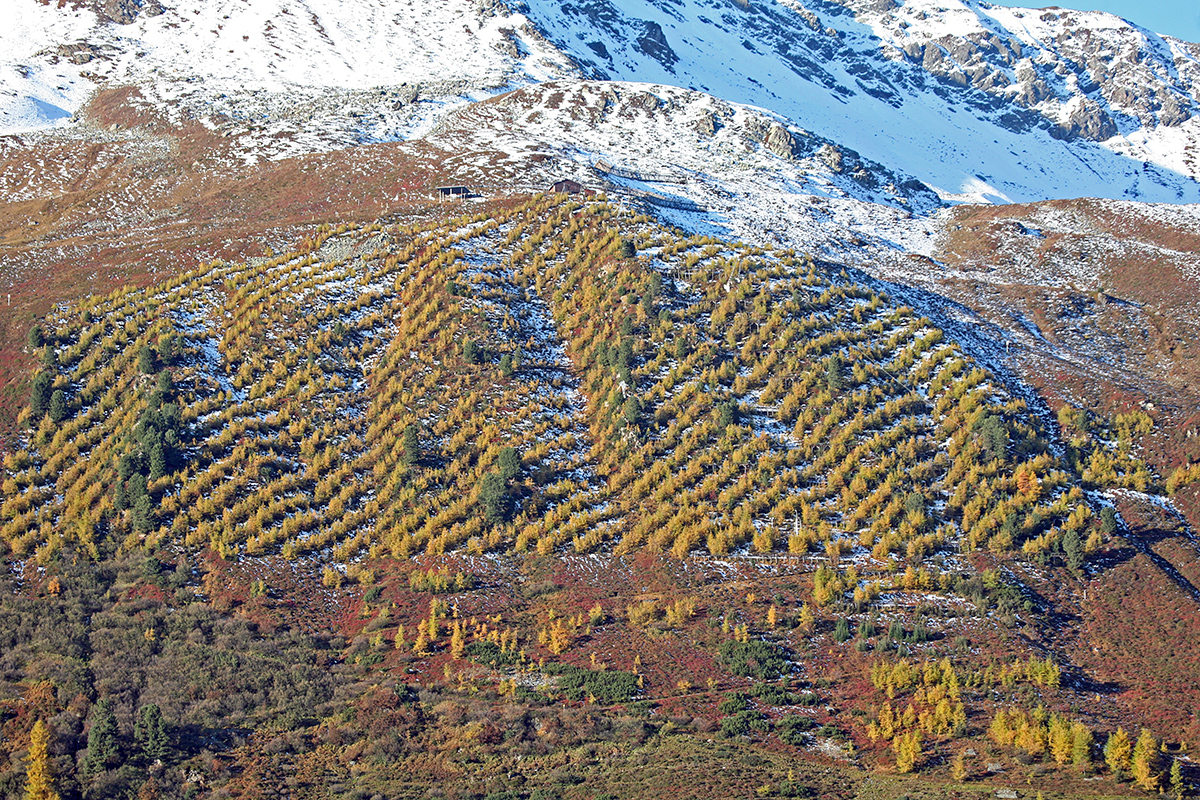
Fig. 2 - In the afforestation experiment Stillberg near Davos the Swiss Federal Institute WSL has for 50 years been researching high elevation afforestation techniques and the ecology of the timberline area. For this purpose 92'000 trees were planted 30 years ago in a repeated experimental design. Photo: Ulrich Wasem (WSL)
Man made timberlines in the Alps
The critical temperature conditions required by trees during the vegetation period - and therefore the level of the tree-line - vary in altitude worldwide depending on the climatic region: from a few 100m in sub polar regions to over 4000m – maximum 4900m – in tropical alpine regions. In the Alps the altitude of the timberline also varies. It reaches its highest levels in the central alpine valleys of Wallis and Engadin with a height of 2500m, where radiation and the ratio between the warm soil and the surrounding air temperature is at a maximum. On the exposed peaks of the Pre-Alps the trees usually have too little summer warmth at an altitude of only 1800m.
The close connection between temperature and tree growth leads to the presumption that the timberline would rise with the on-going climatic warming. However, forests are sluggish systems. It takes decades until they spread out into former open terrain. The timberline therefore lags behind the actual climate.
In the Alps the timberline has for hundreds of years always been extremely influenced by humans. Due to grazing and forestry it was often pushed well below its natural level. After the abandonment of grazing the forests are again expanding and the timberline is once more approaching its natural level. However, we know little about natural fluctuations in the timberline in the Alps. The discovery of wood remnants in retreating glaciers points to the fact that the timberline was at one time above its present level.
Increasing timberline in the remote Ural Mountains
Unlike in the Alps, where it is difficult to differentiate between climatic and land-use related increases of the timberline, in the Russian Ural Mountains the timberline is hardly affected by humans. Scientists from the Swiss Federal Institute for Forest, Snow and Landscape Research (WSL) and the Swiss Federal Institute of Technology, (ETH) Zürich are together with Russian and German colleagues investigating the shifting timberlines in the Southern and Polar Ural Mountains. In the southern area of the Urals the timberline stretches nearly to the highest mountain peaks. Spruce trees grow here up to an altitude of 1300m. In the polar area of the Urals however, larches form the timberline. Here it reaches an altitude of only 300m; above this are spacious areas of tundra and rocky landscape.
Russian scientists have found photographs taken in some of these mountain regions at the beginning of the 20th Century. Comparisons with these historical documents show that the present timberline is around 60 to 80m higher, which on these flat, slightly sloping slopes corresponds to a distance of 500 to 900m. Because human influence can be ruled out in this remote area scientists presume that this altitudinal increase is related to climatic changes. In the Polar and Southern Urals the average temperatures have increased by approximately 1.5°C and the vegetation period is now around one to two weeks longer. Since the 1960’s Russian ecologists have regularly been photographing distinctive points along the timberline of the Southern and Polar Ural regions. They have also plotted on graph paper the position of the timberline and the spread of the different types of forests. These photographs clearly indicate that the timberline is rising. Today young forests are growing where 40 years ago only open tundra was to be found. And closed forests can be found where before only individual trees were able to survive.
Fossil woods above the timberline
In his hikes near the polar circle the 72-year-old Professor Stepan Shijatov stumbled across exceptional witnesses of past climatic conditions. Above the highest standing trees he found remains of fossil forests, the remnants of several meter high larch trees. The age of the extinct forests was determined with the help of the growth rings: the wood was around 1000 years old.
This shows that one millennium ago the climate in the polar Ural region was similar to that of today. Due to climatic cooling during the little ice age of the 13th and 14th centuries the trees died. The fossil larches however remained intact due to their high resin content and to specific climatic conditions – short, dry summers and icy winters. Today young trees and larch seedlings can once again be found growing amongst the fossil remains of the wood. Due to the climate warming the forest is re-conquering lost terrain.
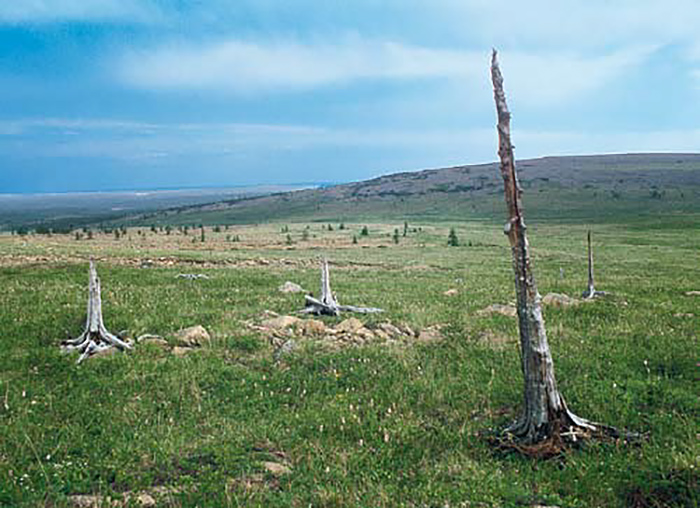
Fig. 4 - Fossil forests above the present timberline in the Polar Urals show that around 1000 years ago it was as warm as it is today. Photo: Frank Hagedorn (WSL)
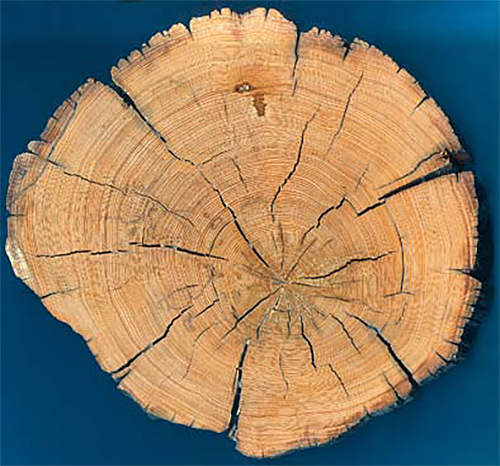
Fig. 5 - Cross section of a 1000 year old fossil larch trunk with 199 well preserved growth rings. The age of fossil wood can be determined by comparison with “Master Chronologies”. The growth rings allow us to reconstruct past climatic conditions. Photo: Andreas Rigling (WSL)
Translation: Dawn Meister, Stallikon

